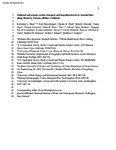Sediment and organic carbon transport and deposition driven by internal tides along Monterey Canyon, offshore California
| dc.contributor.author | Maier, KL | |
| dc.contributor.author | Rosenberger, K | |
| dc.contributor.author | Paull, CK | |
| dc.contributor.author | Gwiazda, R | |
| dc.contributor.author | Gales, Jenny | |
| dc.contributor.author | Lorenson, T | |
| dc.contributor.author | Barry, JP | |
| dc.contributor.author | Talling, PJ | |
| dc.contributor.author | McGann, M | |
| dc.contributor.author | Xu, J | |
| dc.contributor.author | Lundsten, E | |
| dc.contributor.author | Anderson, K | |
| dc.contributor.author | Litvin, SY | |
| dc.contributor.author | Parsons, DR | |
| dc.contributor.author | Clare, MA | |
| dc.contributor.author | Simmons, SM | |
| dc.contributor.author | Sumner, EJ | |
| dc.contributor.author | Cartigny, MJ | |
| dc.date.accessioned | 2019-09-20T10:55:06Z | |
| dc.date.available | 2019-09-20T10:55:06Z | |
| dc.date.issued | 2019-09-12 | |
| dc.identifier.issn | 0967-0637 | |
| dc.identifier.issn | 1879-0119 | |
| dc.identifier.other | 103108 | |
| dc.identifier.uri | http://hdl.handle.net/10026.1/14928 | |
| dc.description.abstract |
Submarine canyons are globally important conduits for sediment and organic carbon transport into the deep sea. Using a novel dataset from Monterey Canyon, offshore central California, that includes an extensive array of water column sampling devices, we address how fine-grained sediment and organic carbon are transported, mixed, fractionated, and buried along a submarine canyon. Anderson-type sediment traps were deployed 10–300 m above the seafloor on a suite of moorings anchored between 278 and 1849 m water depths along the axial channel of Monterey Canyon during three consecutive 6-month deployments (2015–2017). Tidal currents within the canyon suspended and transported fine-grained sediment and organic carbon that were captured in sediment traps, which record the composition of sediment and organic carbon transport along the canyon. High sediment accumulation rates in traps increased up-canyon and near the seafloor, where fine-scale (<1 cm) layering was increasingly distinctive in CT scans. There was no along-canyon trend in the organic carbon composition (percent modern carbon and isotopic signatures) among trap locations, suggesting effective mixing. Organic carbon content (weight percent total organic carbon) and excess 210Pb activities (dpm/g) increased down-canyon, reflecting reduced flux of sediment and organic carbon into deeper water, more distal traps. Differing organic carbon signatures in traps compared with previous measurements of seabed deposits along Monterey Canyon suggest that organic carbon transported through the canyon with internal tides may not be consistently recorded in seafloor deposits. First-order estimates from comparing organic carbon content of core and trap samples results in low organic carbon specific burial efficiency (ranging from ~26% to ~0.1%) and suggests that the modern upper Monterey Canyon may not be an effective sink for carbon. Organic carbon isotopic signatures from sediment traps in the water column show more marine influence than seafloor sediment cores; this is likely due to the deposition and reworking of seafloor deposits by sediment density flows and preferential consumption of fresh marine organic carbon on the seafloor, which is better preserved in the traps. Sediment and remaining organic carbon in canyon floor and lower flank deposits preferentially reflect episodic sediment density flow events that are unrelated to internal tides. This study provides a quantified example and conceptual model for internal-tide-related sediment and organic carbon transport, mixing, and burial trends along a submarine canyon that are likely to be similar in many canyons worldwide. | |
| dc.format.extent | 0-0 | |
| dc.language | en | |
| dc.language.iso | en | |
| dc.publisher | Elsevier | |
| dc.subject | Submarine canyon | |
| dc.subject | Sediment trap | |
| dc.subject | Internal tide | |
| dc.subject | Organic carbon | |
| dc.subject | xs(210)Pb | |
| dc.title | Sediment and organic carbon transport and deposition driven by internal tides along Monterey Canyon, offshore California | |
| dc.type | journal-article | |
| dc.type | Journal Article | |
| plymouth.author-url | https://www.webofscience.com/api/gateway?GWVersion=2&SrcApp=PARTNER_APP&SrcAuth=LinksAMR&KeyUT=WOS:000498753400003&DestLinkType=FullRecord&DestApp=ALL_WOS&UsrCustomerID=11bb513d99f797142bcfeffcc58ea008 | |
| plymouth.issue | 0 | |
| plymouth.volume | 153 | |
| plymouth.publication-status | Published | |
| plymouth.journal | Deep Sea Research Part I: Oceanographic Research Papers | |
| dc.identifier.doi | 10.1016/j.dsr.2019.103108 | |
| plymouth.organisational-group | /Plymouth | |
| plymouth.organisational-group | /Plymouth/Faculty of Science and Engineering | |
| plymouth.organisational-group | /Plymouth/Faculty of Science and Engineering/School of Biological and Marine Sciences | |
| plymouth.organisational-group | /Plymouth/REF 2021 Researchers by UoA | |
| plymouth.organisational-group | /Plymouth/REF 2021 Researchers by UoA/UoA07 Earth Systems and Environmental Sciences | |
| plymouth.organisational-group | /Plymouth/Users by role | |
| plymouth.organisational-group | /Plymouth/Users by role/Academics | |
| dcterms.dateAccepted | 2019-09-06 | |
| dc.rights.embargodate | 2020-9-11 | |
| dc.identifier.eissn | 1879-0119 | |
| dc.rights.embargoperiod | Not known | |
| rioxxterms.versionofrecord | 10.1016/j.dsr.2019.103108 | |
| rioxxterms.licenseref.uri | http://www.rioxx.net/licenses/all-rights-reserved | |
| rioxxterms.licenseref.startdate | 2019-09-12 | |
| rioxxterms.type | Journal Article/Review |


